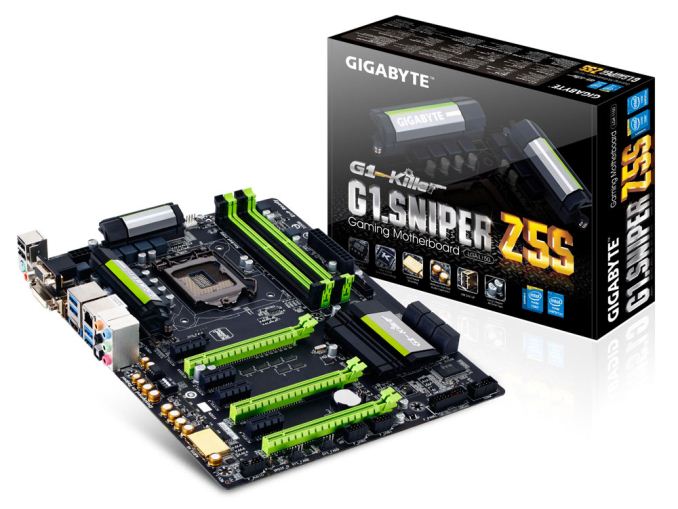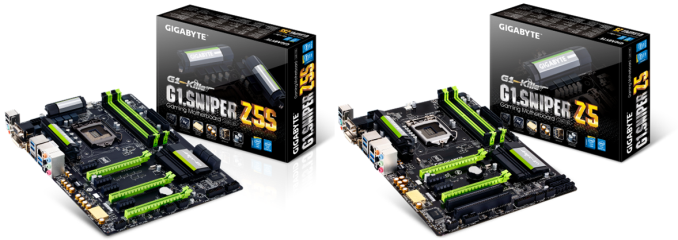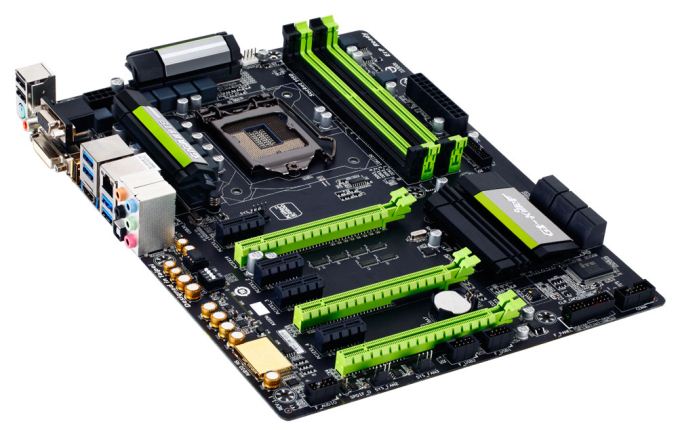G1.Sniper Mid-Range Expansion: GIGABYTE Launch Z5S and Z5
by Ian Cutress on January 3, 2014 6:45 PM EST- Posted in
- Motherboards
- Gaming
- Intel
- Gigabyte
- Z87

All the main motherboard manufacturers now have three distinct classes of motherboard to sell to the common home-build end user: the channel range, the overclocking range and the gaming range. GIGABYTE color codes their models such that the channel range is blue/black, the overclocking range is orange/black, and the gaming range is green/black. The gaming range from GIGABYTE has seen an explosion in terms of models available recently – initially for a couple of generations it was one or two models, but in 2013 we had the following:
-
Intel 8-series:
- G1.Sniper 5 ($380)
- G1.Sniper M5 ($203)
- G1.Sniper Z87 ($170)
- G1.Sniper B5 ($100) -
Intel 7-series:
- G1.Sniper 3 (our review)
- G1.Sniper M3 (our review) -
AMD:
- G1.Sniper A88X ($110)
GIGABYTE is a very market focused motherboard manufacturer, often designing product to match specific requests in various regions. To this end, over the course of the CES weekend we have the two first new 2014 G1.Sniper motherboards being released on the Z87 platform, aimed more at the mid-range gamer: the G1.Sniper Z5S and the G1.Sniper Z5.
Some of the 2013 innovations on the G1.Sniper range include the upgradable OP-AMP feature that lets audio enthusiasts change the operational amplifier to cater their music tastes better, AMP-UP which uses the high end Realtek ALC1150 codec in a tuned and configured environment (EM shield, filter caps, PCB separation of digital and analog signals), USB DAC-UP which provides clean USB power to one USB port to minimize potential fluctuations when using a USB DAC, and Gain Boost to adjust amplification modes depending on the output device. GIGABYTE wraps this up with a Killer network interface to optimize gaming traffic by bypassing the Windows Network Stack.
The G1.Sniper Z5S will be released first, with the Z5 in a few weeks. The Z5S will have most of the features listed above, and use the Z87 chipset in an x8/x4/x4 configuration for tri-CFX compatible setups or in x8/x8 for two-way SLI, along with AMP-UP, OP-AMP, USB DAC-UP, a Killer NIC, and GIGABYTE’s updated BIOS/Software package for Z87.
As these are mid-range motherboards, we have the six SATA 6 Gbps from the PCH and six USB 3.0 ports rather than additional controllers: the main selling point here is a basic motherboard improved through the Sniper series features. The main difference between the Z5S and the Z5 will be only two-way CrossFire on the Z5, with also fewer VRMs in the power delivery and the SATA ports at the bottom of the board rather than in the right-angled fashion we usually see. With these specifications they seem straddle the G1.Sniper Z87, which has more VRMs than the Z5 but the same two-way GPU layout than the Z5, as well as more gold plated connectors on the rear IO.
We are waiting for release dates and prices for both models, but we are told the Z5S will be on sale first. We have the G1.Sniper Z87, the middle one of the three, in for review in due course. Stay tuned for that!


















17 Comments
View All Comments
silenceisgolden - Friday, January 3, 2014 - link
I'm very curious as to why there are VGA ports on these boards. Seems like a large waste of space.LauRoman - Friday, January 3, 2014 - link
Because some of us still have 3 16:10 monitors that only have a vga connection. :)I'm more curious why there's an odd nu,ber of usb ports on the back. Namely what is the single usb port between the HDMI and DVI connectors is doing there by his lonesome.
apunari - Friday, January 3, 2014 - link
Well if you bothered to read, that odd usb port should refer to the usb dac port.DigitalFreak - Friday, January 3, 2014 - link
Wow, double fail. You can't run 3 VGA monitors on this one.EnzoFX - Saturday, January 4, 2014 - link
Yes, it is. I don't understand what happened to the concept of using DVI/HDMI to VGA adapters, I'm sure they can do some breakout cable or whatever. I mean, who needs all of those connectors? I still hate that an old board has 8 to 10 USB ports, but now that graphics are integrated into CPU's, you only get 6 usb ports in the rear.... Just feels stupid stubbornness so support everything rather than have some focus.amrs - Saturday, January 4, 2014 - link
I chafed too and looked for a motherboard without the useless connectors but had to cave in. There doesn't seem to be any. Maybe it's just cheaper on the whole? Less support calls and RMAs? Less complaints when the cheapest adapter from eBay doesn't work?One might think Apple users have proven people can handle adapters but they have the Apple stores for help.
nevertell - Sunday, January 5, 2014 - link
Doing HDMI or DVI-D to VGA is quite problematic as it requires an active adapter. DVI-I and DVI-A are the ones that support passive VGA adapters as they both are capable of providing analogue outputs on their own.On the other hand, what will you possibly do to populate those 10 USB ports ? And if you need more ports, buy a PCI/express adapter and stop whining. USB ports will soon be depreciated for the most part, as everything other than a plain, dumb data drive won't be able to interact with your PC wirelessly. That, and discrete DAC's, microphones and cameras.
abhaxus - Saturday, January 4, 2014 - link
Ugh. I was really torn between the G1.Sniper Z87 and the MSI GD65, eventually decided on the GD65 because I wanted the third PCIe x16 slot and wondered why they had 2 PCI slots on the Z87... just ordered my GD65 yesterday :(Guess I'll be selling this one on eBay and upgrading again when the Z5S comes out. Looks like my ideal board, with the DAC-UP and all.
Achaios - Saturday, January 4, 2014 - link
I did extensive reading on these boards as I recently upgraded to Asus Maximus VI Hero+i7-4770k.No matter how hard I tried, I just couldn't bring myself to buying one of these over the Asus Maximus VI Hero. Here's their drawbacks:
1. Terrible colour scheme.
2. Bad, dysfunctional BIOS. I still remember very unfavourably the GA-P35-DS4 and its terrible, dysfunctional BIOS. This was a motherboard that they marketed as "the absolute overclocker's dream machine" and its BIOS did not even have detailed voltages in it. E.g. when adjusting the CPU VCORE or the NB voltage, there was no way to see from within BIOS what voltages one was setting. They only had stock, +0.1, +0.2, +0.3 type selections. Nobody knew what was the value of the voltages they were setting as in ASUS boards. It could be 1.4V or 2.4V, your guess was as good as mine.
The mere thought of having to go through this torture of guessing my way through Gigabyte's dysfunctional and unfriendly BIOS was a major letdown.
3. Way too much emphasis on onboard sound chip:
These motherboards basically put waaaaayyy too much emphasis on onboard sound quality, smt that never interested me the slightest, though a gamer. I am using discrete GPU audio, and if for some reason I am dissatisfied by it, I will buy a Soundblaster. Therefore, insofar as I am concerned you could have onboard a $5 sound chip or the best sound chip in the world, it makes no difference as I will never use it.
4. Notoriously bad overclocking performance:
Before buying, I made a survey by browsing top Physics and overclocking scores at 3D Mark 11 for the 4670k and the 4770k. I didn't find not even one Gigabyte motherboard who came on top overclocking wise. Gigabyte motherboards all invariably sucked both in terms of Physics scores as well as in terms of highest overclock achieved.
Then I remembered what had happened to me with their terribad GA-P35-DS4 which they marketed as the "overclocker's dream machine" [sic] and my QX9650. I never managed to overclock my QX9650 beyond 3.8 GHz until I bought an ASUS P5Q Deluxe (the very day installed it I reached 4.2 GHz) replacing the GA-P35-DS4, so real life benchmarks seemed to agree with my very bad former experience with Gigabyte.
5. Way too little attention on overclocking potential:
I don't know who had this brilliant idea to separate the "gamer" market and the "overclocker" market. Insofar as I am concerned, these two niche markets are one and the same. I am a gamer, but I am also a serious overclocker and I have been overclocking for many years (I had originally learned how to overclock and tune through reading ANANDTECH articles on X48 chipsets).
A serious gamer will overclock for max performance. Therefore, I want to buy gamer oriented boards who put much emphasis on overclocking such as the ASUS Maximus VI Hero, not onboard sound chip oriented boards which are bad overclockers and have got dysfunctional BIOSes.
abhaxus - Saturday, January 4, 2014 - link
Did you really just use a 5-6 year old board to complain about Gigabyte bios and overclocking? By that logic I wouldn't buy any product from any company, ever.